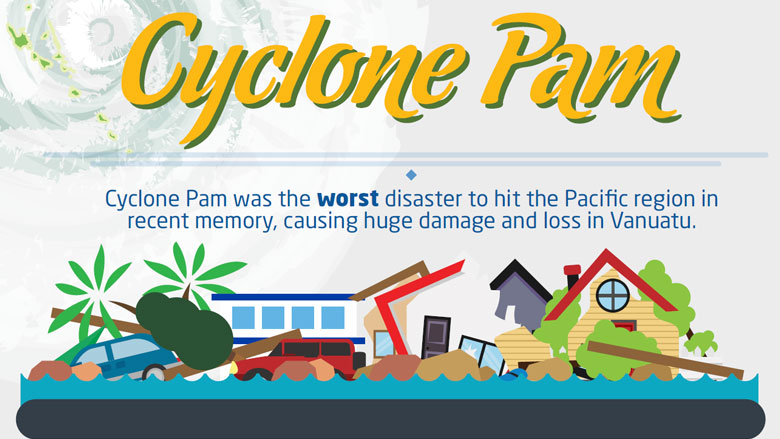Port Vila, Vanuatu – Just over six months ago, Tropical Cyclone Pam etched itself into the memories of all across the Pacific. Between March 12 and 14, the Category 5 cyclone cut a path of destruction through the island nation of Vanuatu, packing wind gusts of up to 320km/hour (199 miles/hour), sustained winds of 250km/hour (155 miles/hour) and four meter-high (13 feet) king tides that swept away entire villages, swallowing infrastructure and destroying hundreds of acres of crops.
Yet while the people of Vanuatu are remarkably resilient to disasters – being a nation whose country was listed by the United Nations Institute for Environment and Human Security as the world’s most at-risk country for natural disasters – Cyclone Pam was different. This was the largest cyclone in recorded history to make landfall in the Pacific.
“We were left with nothing”
Six months on from the storm, Remo Paul, a teacher living on Efate – the largest of Vanuatu’s 83 islands – described the heartbreak of emerging from shelter as Pam passed:
“I saw everything was damaged – houses collapsed, trees fallen, roofing hanging up on the trees. People were just sitting down, thinking about no other thing at all except ‘what should we do?’”
Isabel Kalo, a resident of White Sands village on the north-eastern side of Efate was equally shocked at the sheer force of the storm:
“In the morning after…we came back and saw that our house was all gone. The water blew out our house. There was just the coral, with nothing left over. Our clothes and kitchen are gone. We were left with nothing.”
A remarkably low death toll
Yet despite the scale of the destruction caused by Cyclone Pam, the death toll in Vanuatu remained remarkably low at 11, a small number relative to the impact of other major storms of similar magnitude. Category 5 Super Typhoon Haiyan, for example, which struck the Philippines in 2013, killed more than 6,300 people.
How did the death toll remain so low? There is no doubt that the fact that many communities had emergency preparation plans in place was critical, as was the resilience of the ni-Vanuatu people, who frequently live through earthquakes, large storms and the threat of tsunami and volcano eruptions.
There is also unanimous agreement across Vanuatu that the frequent, comprehensive warnings of the Government of Vanuatu’s National Warning Centre played a vital role in reducing the number of lives lost. The Centre, based in the capital Port Vila, was responsible for ensuring essential information and instructions were disseminated via radio, social media and SMS messages across Vanuatu.
Operating 24 hours a day, seven days a week since November 2013, the National Warning Centre has been supported by the World Bank since its inception. The support has helped to strengthen the National Warning Centre’s operations, and played an important role in the set-up of communication systems with existing volcano, seismic and weather observation stations, including on Vanuatu’s outermost islands.
Cyclone Pam: warnings save lives
As Cyclone Pam approached, the Centre began issuing warnings – categorized by color, according to threat levels – to Vanuatu’s 270,000 residents. Messages also included instructions on suitable places to take shelter, and when to do so. Thirty eight different SMS warnings were sent to Vanuatu’s 160,000 mobile phone users – meaning more than six million messages were received across the country in the lead up to and during the cyclone.
Yama Natuka, a French teacher living on Efate in a community of 30 families says the messages were critical in ensuring he and his community got to safety:
“Before the storm I received a text on my phone. It said, ‘A storm is coming, you must get prepared. It is some kilometers away, but you must get prepared before it gets any closer.’”
“After we’d prepared our homes we looked for a safe place, so we needed to move out from where the homes were and go to a house where it was stronger.”
In addition to preparing his own family for the impending storm, Yama was also able to use the warning messages to regularly update others in his village on the storm’s approach, on the necessary actions to take, and when it was safe to emerge from shelter.

